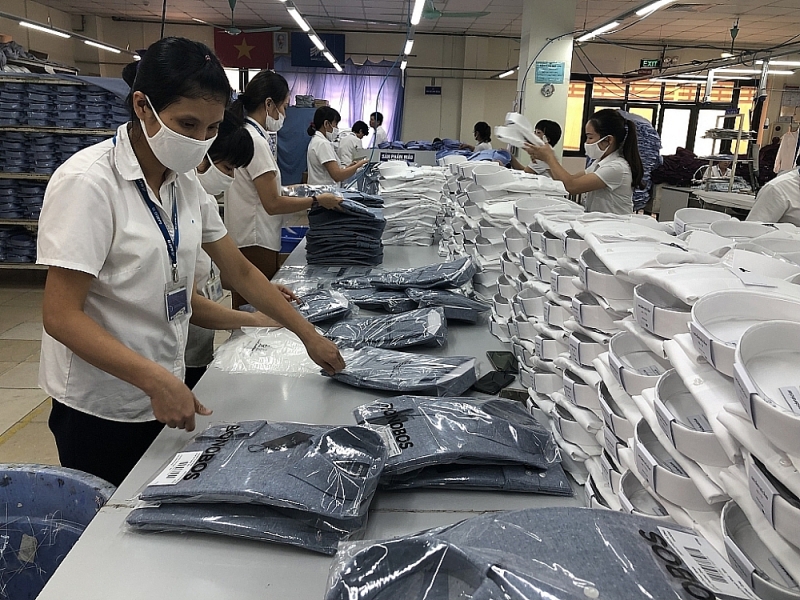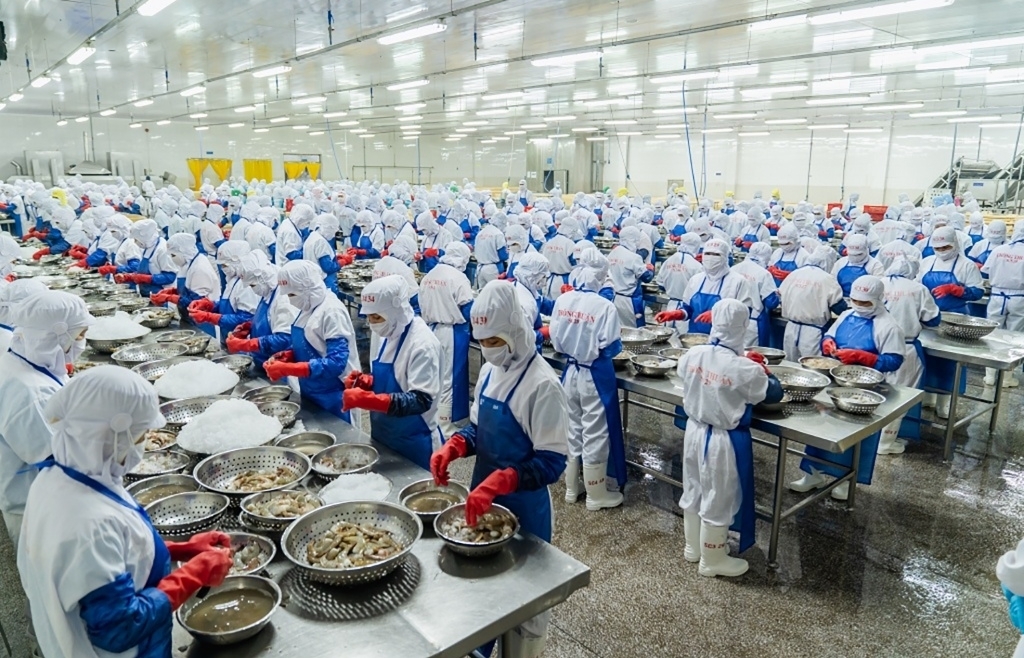Textile and garment exports are not as expected despite EVFTA
 |
| Illustration: H.Diu |
According to statistics of the Agency of Foreign Trade (Ministry of Industry and Trade), from August 1, 2020 (the effective date of the EVFTA) to December 31, 2020, Vietnam's textile and garment export turnover to the EU issuance of C/O form EUR.1 under the EVFTA reached US$216 million.
In the first quarter of 2021, this figure has reached more than US$199 million.
Although Vietnam's textile and garment export turnover using C/O form EUR.1 in 2021 has seen an increase compared to 2020, this figure still only accounts for a small proportion of the total export turnover of textile in general to the EU market (accounting for nearly 30% of export turnover in the first quarter of 2021).
In the EVFTA's special issue, which was developed and promulgated by the Agency of Foreign Trade (Ministry of Industry and Trade) in collaboration with the Vietnam Industry and Trade Information Centre (Ministry of Industry and Trade), on June 1, 2021, the two above-mentioned units gave their assessment: “The rate of using C/O form EUR.1 of Vietnamese textile and garment export to the EU to take advantage of the preferential tariffs has not yet met the expected level".
Usually, there are two main reasons why exported goods do not use C/O to enjoy preferential tariffs. The goods already have a very low or zero-base import tax rate or the goods do not meet the rules of origin under the agreement.
In the EU's import tariff, the number of textile products with the base tax rate of 0% is very small, most of the EU's textile and apparel tax rates range from 3% to 12%.
The EU tax reduction roadmap for Vietnamese textiles and garments is up to 7 years. In the first year when the EVFTA comes into effect, some textile products with a long tax reduction roadmap will have higher tax rates than the corresponding tax rates currently applied in the Generalized System of Preferences (GSP).
Meanwhile, the EU allows Vietnam's exports to continue to be subject to GSP tax even after the EVFTA takes effect with a 7-year roadmap. Therefore, many enterprises will continue to choose the GSP mechanism instead of the EVFTA when exporting textiles to the EU.
Besides, the rules of origin of textiles and garments in the EVFTA are considered to be stricter than many FTAs that Vietnam is participating in (such as the ATIGA or the ASEAN+ Agreements).
"The rules of origin of goods in the EVFTA are considered a big challenge for Vietnam's textile and garment industry to increase exports and enjoy preferential tariffs from this Agreement," the representative of the Agency of Foreign Trade said.
The origin criteria of textiles and garments in the EVFTA are built on the "fabric forwards" rule, which means that fabrics used to cut and sew into clothes must originate from the EU or Vietnam according to EVFTA.
For goods that are textile materials, the EVFTA specifies the steps to be taken for goods to be considered as originating, not merely a criterion for converting commodity codes as in some other Agreements that Vietnam is participating in.
While Vietnam's textile and garment industry imports a large turnover of raw fabrics from many markets around the world such as China, Korea, Taiwan, Japan, etc., the number of raw fabrics imported from the EU is very modest (US$133.55 million, accounting for 1.12% of cloth import turnover in 2020).
Thus, Vietnam's textile and garment products can only use fabrics of EU origin or fabrics produced in the country as raw materials for the production of textile and garment for export to the EU.
However, the domestic fabric production capacity is still not enough to meet the export production needs of the textile and garment industry to the EU in particular as well as to the world in general.
“To meet the needs of textile production for export to the EU, in the long term, Vietnamese enterprises need to have a plan to invest in machinery, equipment, and technology to improve the production capacity of domestic raw fabrics, and not depend too much on imported raw materials," the representative of the Agency of Foreign Trade said.
Textiles and garments are some of Vietnam's key export products to the EU market. When the EVFTA came into effect, the textile and garment industry is assessed as being able to take advantage of and benefit greatly from this agreement due to the EU's commitment to open the market for Vietnamese textiles in the EVFTA up to 100% with a maximum reduction schedule of 7 years.
To enjoy preferential tariffs from the EVFTA, Vietnamese textile and garment products must meet the provisions of the rules of origin of goods under this agreement and be granted a Certificate of Origin (C/O) form EUR.1 under the EVFTA.
Related News

Revising policies to adapt to two-way impact of FTAs
09:24 | 10/11/2024 Finance

Export turnover of computer, electronic products and components reaches over US$ 55 billion
10:06 | 08/11/2024 Import-Export

Export target for 2024 set at US$400 billion
15:02 | 11/10/2024 Import-Export

Customs sector has collected VND 300 trillion to state budget in 9 months
09:22 | 06/10/2024 Customs
Latest News

VN's food processing industry struggles to improve quality and value chain integration
15:53 | 22/11/2024 Import-Export

Approach strategy of the seafood industry when implementing UKVFTA
09:26 | 22/11/2024 Import-Export

Mid-November: Vietnam's trade volume matches 2023 total, eyes record-breaking growth
09:25 | 22/11/2024 Import-Export

Vietnamese enterprises facing challenges from cross-border e-commerce platforms
14:32 | 21/11/2024 Import-Export
More News

Vietnam, Malaysia eye new milestone in trade ties
14:29 | 21/11/2024 Import-Export
Shrimp exports surge in 10 months, generating 3.2 billion USD
14:27 | 21/11/2024 Import-Export

Vietnam’s exports to the U.S. near US$100 billion milestone
09:46 | 21/11/2024 Import-Export

From the “abnormal” coffee price, worries about the new crop
09:46 | 21/11/2024 Import-Export

What obstacles limit the market share of Vietnamese goods in the UK?
14:49 | 20/11/2024 Import-Export

Why seafood exports to some Middle Eastern Countries are stalled
14:47 | 20/11/2024 Import-Export

Storm No. 3 destroys profits of many insurance companies
14:45 | 20/11/2024 Import-Export

Vietnam, Malaysia eye golden partnership opportunities in Halal industry
14:44 | 20/11/2024 Import-Export

Tra fish sector aiming for production, processing greening for sustainable development
14:41 | 20/11/2024 Import-Export
Your care

VN's food processing industry struggles to improve quality and value chain integration
15:53 | 22/11/2024 Import-Export

Approach strategy of the seafood industry when implementing UKVFTA
09:26 | 22/11/2024 Import-Export

Mid-November: Vietnam's trade volume matches 2023 total, eyes record-breaking growth
09:25 | 22/11/2024 Import-Export

Vietnamese enterprises facing challenges from cross-border e-commerce platforms
14:32 | 21/11/2024 Import-Export

Vietnam, Malaysia eye new milestone in trade ties
14:29 | 21/11/2024 Import-Export





